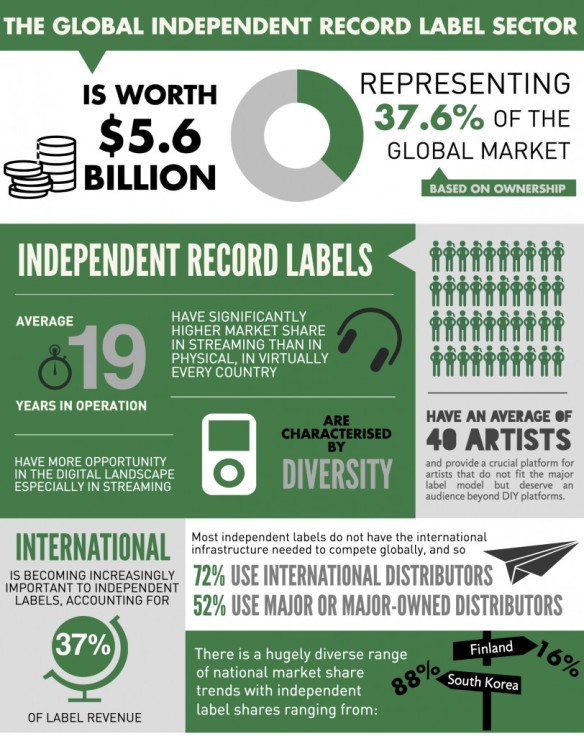General wisdom suggests that indie labels account for about 20% of global revenue, but a recent study has revealed that their share is in fact much greater than previously suspected, something which has broader implications with regard to the independent sector‘s ability to compete globally.
____________________________________
Guest Post by Mark Mulligan on his Music Industry Blog
Over the course of the last year MIDiA has been working with WIN (the global indie label trade body) on a major study to define the independent sector’s contribution to the global recorded music business. The default accepted wisdom is that the indies account for something like 20% of the global revenue total. However, this study revealed, that figure strongly underestimates the actual share…it is in fact 37.6%. This matters not for bragging rights but because in the digital marketplace, market share shapes the deals that are struck, with more market share translating into better terms. So a more accurate measure of share can help the independent sector compete on fairer terms.
Distribution Versus Ownership
Distribution is the largest single contributor to the variance in market share. The 20% refers to the labels that distribute the music while the 37.6% refers to which labels actually own the music. Indeed, 3rd party distribution is becoming an ever more central element of the independent sector. The growth of streaming services and social media have helped create a burgeoning international opportunity for independent labels across the world. However, because most of these labels do not have the international infrastructure required to tap this global opportunity they often utilise 3rd party partners for distribution and other services. Often these parties are major labels or major label owned distributors. As the music market becomes more global, 3rd party distribution becomes more important for indies. But while this gives the independent sector global scale it also means that much of their revenue ends up being accounted as major label revenue, creating a distorted view of the market.
Most Indies Use International Distributors
In fact, 72% of independent labels use a 3rd party international distributor while 52% use a major label owned one or go direct via a major for distribution. The impact on the global market is huge. Just look at 2 of the biggest independent artist albums recently: Taylor Swift’s ‘1989’ on Big Machine but distributed by Universal Music, and Adele’s ‘25’ on XL/Beggars but distributed by Sony in the US and South America. 2 leading independent success stories that now appear as major label success stories in investor decks. There is no questioning the value that majors and major owned distributors bring but just as importantly these are nonetheless indie label artists.
A Diverse Global Picture
Even using the ownership approach, there is a massively diverse global picture, with indie market share ranging from just 16% in Finland, up to 64% in Japan and 88% in South Korea. In fact, Japan, South Korea and the US (where the distribution methodology has been in place for a few years now) account for 64% of all global indie revenue.
The disparity between ownership and distribution measures will only increase as music’s shift to streaming accelerates. The more that international markets open up, the more that smaller labels need to utilize international partners to reach music fans in those markets. And the more that happens, the less relevant distribution market share becomes.
You can download the entire report by following this link.
Meanwhile, this graphic highlights some of the key findings.
